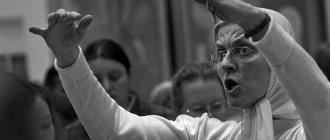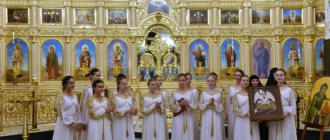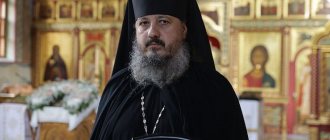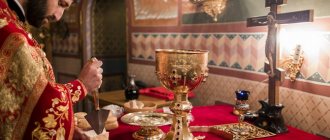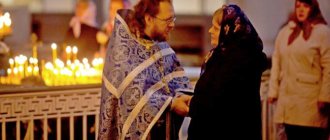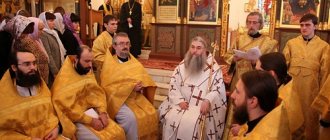Baptism of Rus'
After the official adoption of Orthodoxy, Grand Duke Vladimir began to actively build and equip churches, not forgetting about liturgical singing - he brought singers of Slavic origin with him from Byzantium. By this time, Bulgaria had adapted Byzantine liturgical singing into the Old Church Slavonic language, which was spoken at that time, so the Bulgarian system of singing was closer and more understandable to the Russians than the Greek one.
St. Equal to the Apostles Prince Vladimir
Princess Anne of Byzantium
Tithe Church in Kyiv (reconstruction)
At the same time, under his wife, the Byzantine princess Anna, a Greek choir was created, called “Tsaritsyn”. Gradually, a tradition was established - in the Tithe Church of Kyiv, two choirs sang: one in Greek, and the other, building opposite, in Slavic.
Three directions
Initially, Russian singers only learned to sing according to Byzantine, mainly Bulgarian, models. Little information has been preserved about the first creators of Old Russian chant. It is only known that these were monks who learned to sing “from mouth to mouth.” Gradually, many singing schools arose in Rus': Kiev, Novgorod, Rostov, and already the chronicles of the 11th century tell about “proud” singers.
Over time, three directions emerged:
- "pro-Byzantine";
- "pro-Russian";
- "compromise".
The first direction included the Kiev nobility and the highest Byzantine clergy, who arrived on an Orthodox mission to Rus'. His supporters did not make any amendments or additions to the Byzantine style of singing. In fact, it was a “tracing copy” of Greek chants.
The opposite point of view was held by supporters of Russian antiquity: they proposed using only texts that were “superimposed” on national melodies.
Representatives of the third movement - educated people who belonged to different classes - merchants, clergy, military men who had contacts with Byzantium, adopted texts, notation, octagonism, and compositional techniques from Greek singing art. At the same time, the mode-intonation fund was borrowed from Russian music.
Thus, by comprehending the best examples of the singing art of Byzantium and “grafting” it onto Russian soil, the znamenny pillar chant - the basis of the foundations of Russian liturgical singing.
What does Byzantine music sound like today?
At present, Byzantine singing art remains to a large extent true to the traditions of the 19th century.
The following examples of chants in different voices and, accordingly, in different scales can give an opportunity to imagine how rich and varied in content modern Byzantine music is. These are stichera from the book “Anastasimatrion” (from the Greek word ανάσταση - “resurrection”), chants from which are sung on Sundays throughout the year - just as they are sung today in Greece.
This is what a solid chromatic scale sounds like:
Solid chromatic scale Performance: Irina Starikova and Anna Eliseeva (ensemble "Asmatikon").
© Arzamas And here is the chant of this scale:
Chant in a solid chromatic scale Stichera “Lord, I have called to You” from the book “Anastasimatrion”.
Performed by: Irina Starikova and Anna Eliseeva (ensemble "Asmatikon"). © Arzamas And this is how the diatonic scale sounds:
Diatonic scale Performance: Irina Starikova and Anna Eliseeva (ensemble “Asmatikon”).
© Arzamas The chant of the first voice in this scale sounds like this:
The chant of the first voice in the diatonic scale of the Stichera “Lord, I have called to You” from the book “Anastasimatrion”. Performed by: Irina Starikova and Anna Eliseeva (ensemble "Asmatikon"). © Arzamas
The concept of Znamenny chant
The concept of “chant” is purely Russian. This is not music that accompanies worship and is not a setting of church text to music. In essence, the words were not sung, but pronounced in a chant.
One of the most important foundations of the pillar znamenny chant was strict monophony, however, this did not mean that only one person could perform the chants. On the contrary, the main feature was that everyone sang with “one voice and one heart.” A one-voice choir led and ended the chants only in unison or in octaves. The rhythm of the chants was completely subordinated to the rhythm of the chanted text.
“Whether one person sings or many, the voice seems to come from the same mouth,” St. wrote about prayerful singing. John Chrysostom. It was precisely such a simple and integral melody of Znamenny singing that focused the mind and collected it in prayer.
Where in Moscow you can hear Byzantine singing
In the first time after the Baptism of Rus', it was Byzantine liturgical and singing art that was widespread here. Church singing was strictly monophonic, and to record the melodies of ancient Russian chants they used notation close to Byzantine. Over time, the chant acquired distinctive features, but for some time the connection with Byzantine singing art remained. However, from the end of the 17th century, ancient chant was gradually replaced by a completely different type of church music: harmonic polyphony of the Western European type, which was written using five-line notation. Currently, almost all churches of the Russian Orthodox Church use this style of singing.
Nevertheless, the Old Russian Znamenny chant did not completely disappear. It continues to be heard in Old Believer churches, as well as in individual parishes of the dominant church, for example in the Moscow Church of the Intercession in Rubtsovo.
In addition, recently in some churches in Moscow, chants of modern Byzantine chant in Church Slavonic are performed during services. You can hear them in the Church of All Saints on Kulishki (Alexandria Compound), in the Church of the Great Martyr Nikita (Athos Compound) and in other churches.
Recording of Znamenny singing
To record the znamenny chant, they used a certain system of signs - “hooks” , which were otherwise called pillar banners. Each sign represented from one to eight sounds. At the same time, the exact concept of pitch, duration, color and sound strength was communicated.
Since the 15th century, the names of these signs have been recorded in manuscripts. When deciphering, it became obvious that behind each sound there was a certain image. For example, “hook” is the most common sign, which gave the name to all singing, “paraclete” (comforter), with the proclamation of which the singing began,” “stapitsa” is a sign of recitation, when the words are not sung, but pronounced in a “talker”, “two in chelnu” depicted a boat (shuttle) and two people sitting in it, etc.
Examples of designation of Znamenny chant signs
Long sections of chant were indicated by special signs - fits. The chanting of fita is a time of spiritual contemplation, when a person could perceive the content of the prayer with his heart. This type of marking was called secretly closed. Fites, like signs, had names.
Byzantine singing after Byzantium
17th century Exigisis and callopismos
New Chrysaph, Peter Bereket, Peter of the Peloponnese and Manuel Chrysaph. Illustration from Papadika's Anthology. 1815 © National Library of Greece
The Turkish conquest of Constantinople did not lead to the decline of the musical tradition. The former court singer Manuel Chrysathus continued to work on the island of Crete and became a famous music theorist. In the 17th century, the tradition was preserved by the “new melurgi” - Panoayotis New Chrysapos, New Patriarch Metropolitan Herman, priest Balasius and Peter Bereket. They often changed the concise recording of the melody in the early song books to a more extensive one, the so-called analytical, or exegisis (from the Greek εξήγησις - “interpretation”). Perhaps, at the same time, they not only recorded the melody in more detail, but also could change the melodic formulas themselves. In the manuscripts one can find numerous chants with remarks called “kallopizmos” (from the word καλλωπισμος - “decoration”): these are richly ornamented variations (possibly including simpler ones in musical content) of ancient chants.
XVIII and XIX centuries. Simplifying the notation
In the 18th century, the Constantinople composer and leading choir singer Peter of the Peloponnese reworked the system of notation of melody and simplified the notation, which could now more clearly and in detail reflect complex musical turns. Using the new system, he recorded short, simple chants that had never been recorded before.
The beginning of the kekragarii - sung verses of Psalm 140 “Lord, I have cried to You.” Doxastarios of the early 19th century © Manuscripts Division of the Department of Rare Books and Special Collections, Princeton University Library
Another famous master of Byzantine chant of this time, protopsalt Jacob, created a new edition of Doxastarios, a book of holiday chants. There he also wrote down old melodic formulas in a simpler notation, which reflected their musical content in more detail.
In 1814, an event occurred known as the "Three Masters Reform." Three experts in the art of singing - Archimandrite Chrysanthos of Madit, Hurmuzius Chartophylax and Protopsalte Gregory - transformed the system of recording melody, removing some signs and adding others. The new type of Byzantine notation was not only more convenient to use, but also made it possible to more accurately write complex melodic formulas.
Cherubic, 1st tone. An anthology of the late 18th - early 19th centuries © Manuscripts Division of the Department of Rare Books and Special Collections, Princeton University Library
In addition, Chrysanthus, in his treatise “Theoreticon,” was perhaps the first to describe in detail the system of intervallic genders, or types of scales. Each voice has its own color, or, more precisely, flavor, due to the special intervallic content of the scale that is used in the chants of this voice.
Kondakar singing
Kondakar singing occupied a special place in ancient Russian liturgical singing. The name came from the term “kontakion” , translated from Greek as κοντάκι(ον) from κόνταξ, “stick, pole”, which had the original meaning of “a parchment scroll with the text of a song wound on a stick”, since ancient texts were written on scrolls.
In ancient Byzantium, kontakion played a very important role. It was a multi-stanza extended composition - a theological poem in sounds. He took up quite a lot of time from the service. Only skilled masters mastered kontakary singing: the protopsalt - the main singer - went out to the middle of the temple, ascended to the deacon's pulpit, and from there sang Christ, the Mother of God or the saints in a kontakion composed by himself. Kondakar singing was considered elite and was passed on from master to master.
The recording of kondakar singing was somewhat different from the recording of znamenny chant - there were two lines, as well as signs that emphasized the solemnity of this type of singing. His exact transcript is not available to this day.
Russian monastic songwriters relied on Greek books - kondakari. Since Russian worship, in imitation of Byzantium, gravitated towards pomp and royal luxury, the first festive kontakia were sung in a special solemn chant. Kondakar singing flourished in Rus' in the 11th-12th centuries, but by the 14th century it had disappeared, probably due to the decline of church life associated with the Tatar-Mongol invasion.
From the history of church singing
The history of church singing goes back to ancient times. From a religious point of view, singing, like speech, serves to express high feelings of reverence for God. Even in Old Testament times, they believed that angels and people sing the same songs. In the Holy Scriptures, in appearances to holy and righteous people, angels are represented as a host, divided into choirs or choirs, singing praises to God. The Prophet Isaiah saw the Seraphim surrounding the Throne of God and calling to each other: “Holy, Holy, Holy is the Lord of Hosts” (Is. 6:3). The prophet Ezekiel heard the singing of angels. The Apostle John the Theologian in the Apocalypse repeatedly mentions the singing of the blessed celestials. The first Christian chant was brought to earth by angels on Christmas night. Faith in the musical unity of the earthly and heavenly also determined the view of singing in the earthly church: it is an echo of angelic singing, the language of a person’s rapturous state, a grace-filled means of arousing and expressing prayerful feelings.
The Savior himself and his disciples ended the Last Supper by singing: “...and having sung, she went out into the Mount of Olives” (Matthew, 26, 30).
The apostles were very concerned about liturgical singing. “Whenever you come together, let each one of you sing a psalm,” instructs the Apostle Paul (I Cor. 14:26). In the Apostolic Decrees, the obligation and even the method of liturgical singing are already legalized: “... after two readings... let the psalms of David be sung, and let the people repeat the ends of the verses loudly” (Book II, Chapter 57).
At prayer meetings and services, the first Christians sang, in addition to the psalms of David, Old Testament hymns - two songs of Moses, “Let us sing to the Lord” and “Sound up the heavens”; the song of the prophetess Anna “Strengthen my heart in the Lord”, the songs of the prophets Habakkuk, Isaiah, Jonah. New Testament early Christian hymns were also sung - the song of the Mother of God “My soul magnifies the Lord” and the song of Simeon the God-Receiver “Now you let go.” Already in apostolic times, the Great Doxology “Glory to God in the highest,” “Quiet Light,” “Let all flesh be silent,” “Glory to Thee, Lord, glory to Thee” was compiled and preserved (sung, as now, before the reading of the Gospel and after ), entrance hymn “Come, let us worship” and others.
In the ancient Church, singing was universal - everyone who gathered for prayer sang. Saint John Chrysostom says: “Wives and men, elders and youths are different in gender and age, but there are no differences in singing, because the Holy Spirit, uniting the voices of each, arranges one melody from all of them.”
The Apostolic Decrees indicate even more specifically: “During public worship, at the proclamation of the deacon, the people... exclaim: Lord, have mercy!”
In the ancient Liturgies, the people are instructed to respond to the exclamations of the clergyman “Amen”, “and to your spirit.” And the believers are invited to sing the victory song “Holy, Holy, Holy” especially loudly.
Hieromartyr Ignatius the God-Bearer,
The Bishop of Antioch, following the model of the singing of angels he heard, introduced another method of singing, which became widespread by the 4th century - antiphonal singing, that is, alternating between two choirs. This method is still used to this day on highly solemn occasions - at festive services in large cathedrals and monasteries.
After the end of the persecution, Christian worship, already performed openly, becomes more orderly and solemn.
Naturally, church singing reflects these changes. What was previously subject to public performance is transferred to specially trained singers. Separate faces of the right and left choirs began to form. Books were required for singing - the number of chants constantly increased, the singing became more skillful and refined; It became impossible to know everything and sing by heart. Church singing art gradually moved away from the secular by limiting the number of modes of music permissible for liturgical use. The Western Church in the 4th and early 5th centuries finally established the dominance of singing in four modes (voices). Introduced through the efforts of Bishop Ambrose, it was called “Ambrosian”. Until the 7th century, it developed and expanded in its content - four more new modes were added to the first four. The adoption of a new type of singing - osconsonant, or Gregorian - dates back to the time of Pope Gregory the Dvoeslov, although it is possible that this happened later.
In the Eastern Church, the development of singing also went towards osmoglasis, in a slightly different way, since it was based on the musical traditions of the ancient Greeks. Already from the 5th century, all eight voices were steadily practiced. Thus, Saint Anatoly, Patriarch of Constantinople,
wrote his Sunday stichera in eight voices;
the monk Romanos the Sweet Singer
composed kontakia and ikos for eight voices .
In the 7th century, Saint James, Bishop of Edessa, wrote the hymns of the Week in eight voices .
But osmoharmony received its full completion as a firmly established system and as the fundamental law of church singing in
Octoechos
in the middle of the 8th century.
The Monk John of Damascus
was to a certain extent the creator of the Octoechos, and primarily a collector and systematizer of it in literary, musical and singing terms.
The Octoechos contains a collection of Sunday stichera, troparions and canons, written at different times by various songwriters, largely by St. John Chrysostom himself,
and distributed into eight groups, according to the number of singing voices, that is, modes.
Saint John became famous as a wonderful songwriter, for which he was nicknamed by his contemporaries the Golden-Swept. He wrote a service for Holy Pascha, 64 canons, many stichera and, finally, completed the compilation of the Octoechos, including in it the best works of his predecessors in osconic creativity and supplementing what was missing with his own creations. He set out the first stichera of each voice and the first troparia of each canon in musical notations (hooks) on top of the text, so that these stichera and troparia (irmos) became a model for singing the stichera and troparia that followed them. In this sense, they were given the names self-vocal, as well as self-similar and similar, while other stichera were called non-self-consonant, that is, having not their own special melody, but a borrowed one, similar to a model. The self-harmonies contained all the characteristic features of each voice and thereby made it possible to understand and assimilate the essence of all osmoglasiya as the basis of church singing. The image of the voices, their musical theoretical content was not a new composition or personal creativity of St. John. He only recorded in a processed and verified form what had been sung for a long time and everywhere, but was unstable.
As a result, Octoechos received the significance of a genuine school of osmoglasiya, a real musical and singing manual for the study of church singing of the entire Eastern Church, which was proven by its rapid and widespread spread in liturgical practice.
History of church singing
in Russia
begins in the 10th century.
In 988, under the Holy Prince Vladimir, the baptism of Kievan Rus took place. Byzantium appeared as her successor during her baptism into the faith of Christ. Thus, the Russian Church accepted not only the doctrine, but also the entire church ritual and, in particular, liturgical singing, in the form in which it was among the Byzantine Greeks. This is, firstly, ready-made text material for all services of the annual circle, translated into Slavic; secondly, ready-made consonant melodies of the Orthodox East in the hook presentation available in liturgical music books; thirdly, the established methods of single and choral church singing in the East; fourthly, the strictly vocal nature of singing and its purely melodic nature, alien to the desire for harmony in the sense of simultaneous chord harmonies.
All this largely predetermined the future fate of Russian church singing.
The most ancient form of Russian singing is considered to be the so-called kondakarnoye.
Its origin is mysterious: similar singing books have not been found anywhere outside Russia. In Russia there are only five manuscripts of this chant, dating back to the 11th and 14th centuries. They are not decrypted. According to some sources, researchers believe that these tunes first appeared not on Russian soil.
When Prince Vladimir invited the Greek clergy and spiritual singers to Kiev, they “brought” with them the so-called Znamenny chant1
(“banner” meant “sign” at that time, that is, singing according to “signs”). The process of formation of the Znamenny Russian Osmoglasiya, which began in the 12th century, was completed only by the beginning of the 16th century. The Polish influence on Russian church singing was undeniable. However, relations between Catholic and Orthodox Christians were by no means warm, and as a result of the struggle against the union, the Orthodox Kyiv brotherhoods developed a fundamentally new type of singing, different from the sound of the Catholic organ. It is also worth noting that it is on the basis of osmoglasia that such types of church song art as track, line and demestine singing are created.
It was in the 17th century that a peculiar flowering of Russian Znamenny singing took place. As experience was gained, various techniques were created to facilitate the performance of chants. So, let’s say, to acquire the ability to sing various texts according to the melody of each of the eight voices, Russian singers had in great use melodic formulas, sung to lighter texts, which was called memory voice. For example, for voice 1 - “The monk has left the monastery”; 2nd - “The second monk met him”; 3rd - “From afar, brother, are you coming”; 4th - “From Constantine City”; 5th - “Let’s sit down, brother, and talk”; 6th - “Is my mother alive, brother?” 7th - “Your mother has died”; 8th - “Woe is me, woe is me, my mother.”
Sometimes the Russians even introduced a comic element here, when, say, they sang the following memorial voice: “Here in Moscow on Varvarskaya Mountain, hear us, Lord.” This memory voice is most likely of school origin. The so-called “master-singing verses”, sung in typical vocal patterns, were common among students. For example, a verse in the 5th tone: “Alas for me and for me, a lazy and careless mountaineer, the teacher forbids me: born child of the father, be intelligible and diligent in holy singing. I, the accursed one, am like a deaf asp, stopping his ears with his foolishness, but I always cry out: look upon me and have mercy on me.” Or on the 7th tone: “The sun is already rising and the day is coming, but I am overcome by sleep, I do not know how to tame the anger of the teachers, but I immediately began to cry out to the teacher: have mercy on me and forgive my foolishness.”
The end of the 16th and beginning of the 17th centuries was a time of correction of liturgical books. The heated debate that arose in the singing world is understandable. The singers clung tightly to antiquity and tradition. But reform was needed both in the field of texts and in the field of singing.
The second half of the 17th century is marked by the transition from znamenny chant to
partes chant2
(from the Latin word partes - voices), which appeared in the church shortly after the adoption of linear notation.
This singing owes its spread largely to the support of Patriarch Nikon
, who, while still Metropolitan of Novgorod, introduced it in his diocese and then moved it to Moscow.
Tsar Alexei Mikhailovich
himself, by decrees, summoned singers from western Russia, and by order of the Moscow government, envoys went to Kiev to get singers. The Great Russian singers also had to take up the study of a new style of singing, which the majority quickly fell in love with.
Tsar Alexei Mikhailovich and Patriarch Nikon began a new era, which replaced the predominance of unison and znamenny chant with the widespread development of choral singing, an abundance of free compositions, as well as short chants. During this period of Kiev influence, the first harmonizations of Znamenny chant appeared in Moscow,
as well as the free creativity of Russian authors.
The number of surviving scores, which were concentrated in the Moscow Synodal Library, indicates the enormous fertility of the first Russian authors, who wrote entire volumes, entire “services.” An important role in the development of this singing in Russia was played by the prominent musician Nikolai Diletsky
, author of the collection “Music Grammar”.
Based on his theory, Russian church singers quickly learned the basics of the new art. Among the composers of the “Polish” trend, one can also note Bavykin, Titov, Kalashnikov and Belyaev.
But since innovations came to us from the West, for many this was enough to deny Partes singing. Patriarch Nikon was accused of having “brought into Russia the singing of Novokiev and Partes, multi-amplified (by several voices) with the movement of all flesh, with the nodding of the head, with anointing (waving) of hands, with disorderly wobbling.”
Surprisingly, not only the authorities turned out to be supporters of the new art; there were also ardent defenders among clergy, who tried to explain and prove to those of little faith that it cannot be considered a heresy, that it is good and completely acceptable. Deacon Ioannikiy argued that not only the new singing is not a heresy, but all music in general is not from the devil, but from God: “Do not be surprised at this,” he said, “if someone praises the old as usual, but blasphemes the newly corrected out of ignorance, having been tempted in the teachings of the books. Musicia makes the church beautiful, adorns divine words with good agreement, rejoices the heart, and brings joy to the souls in the singing of the saints.”
Patriarch Nikon very actively contributed to the spread of partes singing, which was performed under the leadership of Belarusian and Kyiv regents. The main difference between the singing of the invited Kyiv “Spivaks” was that their style seemed much softer and melodic than that of the “Muscovites”. The chants were recorded again in Kiev, that is, using a notation that has become classical - five-linear. The notes, the so-called “Kiev banner,” were square, but the hook notation gradually disappeared from church use and soon completely disappeared. The official date of birth of partes singing is considered to be 1668, when the ban on polyphonic singing in the Russian church was finally lifted.
Polish influence did not last long. In the 18th century, when opera appeared in Russia, a new stage of church chant began, the style of which was formed under the influence of Italian composers. In 1736, to stage an opera by the Italian composer Francesco Arai, they turned to the singers of the court church choir in order to use experienced choral singers, since there was no separate opera choir. This event was destined to open a new chapter in the history of Russian church singing - a chapter called “Italianism”.
Yes, Giuseppe Sarti
somewhat “modernized” the ancient song-hymn of Bishop Ambrose of Milan “We praise God to you.”
Remarkable followers of the Italian school were such prominent composers as Maxim Berezovsky, Artemy Vedel,
the creator of the first national anthem “How Glorious is Our Lord in Zion”
Dmitry Bortnyansky
and
Stepan Degtyarev
. After the intervention of Emperor Paul I, lighter secular compositions were excluded from the church repertoire. But the tradition of the spiritual concert is still alive today.
Church choristers turned out to be excellent opera singers, and some of them even began to compete with Italian soloists. It ended with Italian composers beginning to write concertos for Russian worship. Among them were people with big names not only in secular opera, but also in Italian church music. Galuppi Buranello and Giuseppe Sarti (their works are still sung in Russian churches) were cathedral conductors, one in Venice, the other in Milan.
However, the “newly created” church hymns in the Italian style were received very ambiguously in Russian church circles. “What is the use of the Holy Church,” said one lover of church splendor, “as they sang in a concert: “And we will thunder, and we will thunder, and we will thunder, and we will thunder, and we will thunder from heaven, the Lord.” Yes, up to 30 times similar speeches, sometimes more, choir after choir following through pauses, overtaking, aggravate. The Terrible Judge will thunder, having come to judge the living and the dead, and not with your balalaika noise (I say to the singers), but with terrible thunder. No, we almost sing in other voices: “Woe is us, woe, woe is us, alas, alas, forever alas, endlessly alas.” And not buffoon frets: “And we will roar, and we will roar.” Many, having learned to study the partes from the same multi-nonsense compositions, sing at rapid-fire pauses and sometimes it is so unpleasant that it is miserable to listen to them, for this deep-voiced Russian fool, opening his wide mouth, shouts quickly, like ringing an alarm bell; If he happens to take the top note through pauses, he will take it as unskilfully as a stallion neighs, or at intervals he will tear it off so carelessly, just as a bull roars.”
Of course, the Italian influence is not entirely expressed in such dark tones. His merits were strengthened by the merits of our best “Italian” - Dmitry Bortnyansky. He is the first Russian composer to master all the means of modern musical technology. Most of his compositions are concertos.
Bortnyansky's concerts contain a lot of dramatic pathos and virtuosity - the main features of Italian operatic creativity. In addition to concerts, Bortnyansky made a number of arrangements of church hymns convenient for the choir, without changing their melody. These are, for example, the canon of Great Compline “Helper and Patron”, “Under Your mercy”, “Come, let us bless Joseph of ever-memorable” and others.
Bortnyansky is the last “Italian”; directly behind him, from the 30s of the 19th century, there were a number of composers who made a significant contribution to the development of Russian church singing. This is Pyotr Turchaninov, Mikhail Glinka, Gavriil Lomakin
and
Alexey Lvov
.
The age of “Italianism” has relegated the most ancient chants to last place. Perhaps only monasteries adhered to the singing antiquity and, to a greater or lesser extent, retained the ancient tunes. But harmonic forms were also developed for them. This was especially typical for monastic choirs in southwestern Russia. Of these, the Kiev-Pechersk Lavra stood out in terms of its significance. On the choir of this monastery, a polyphonic form was developed for chanting the usual chant in this monastery, known as the Kyiv chant, but approximately half included the Znamenny chant.
Almost the same thing happened in Great Russian monasteries. Thus, during the heyday of Italian concert music, thanks to the adherents of singing traditions, our ancient chants appeared in simple harmonizations. This is the so-called ancient, touching, monastic
singing.
The melodies of the Kievan, Greek and Bulgarian chants were the first to adopt such simple forms, followed by others, and a whole literature of ancient transcriptions was compiled called Sofronievsky, Lavra, Vyatka, Yaroslavl, Ipatiev, Moscow
, etc.
In parallel with the development of church music in the Orthodox Church, there was a traditional church singing direction, most uncompromisingly represented by the Old Believers
.
Having lost the early forms of linear polyphony, the Old Believers, along with the conservation of znamenny and travel chants, significantly developed the singing repertoire of demestvennik monody (the book “Demestvennik”) and the oral culture of singing according to the tune. Until the 20th century, they preserved, although not universally, hook singing and the culture of a handwritten song book with two main styles of ornamentation - Pomeranian and Guslitsky.
Bortnyansky’s successor as director of the chapel, Fyodor Lvov, was a staunch supporter of the restoration of ancient singing, and on his initiative, Archpriest Pyotr Turchaninov was involved in this matter, who very successfully carried out the task of harmonizing ancient Russian melodies
. With the appointment of a new director of the chapel, his son Alexei Lvov, another style of harmonization was formed. In parallel to the “Italian” Bortnyansky, Lvov, an outstanding virtuoso violinist who enjoyed success in Europe and as a composer, received the nickname “German”. He looked at Russian church singing through the eyes of his German teacher, that is, from the point of view of German harmony. But it is impossible to apply German harmony to Russian church chants, and therefore Lvov changed the original chants where they did not obey the harmony of the German chorale. This method of harmonization was used by Lvov throughout the full circle of chants of the Znamenny chant.
Among purely church composers one can name a number of very prominent personalities, such as Alexander Arkhangelsky, Gabriel Lomakin, Andrei Esaulov, Nikolai Potulov, Pavel Vorotnikov, Vasily Fateev, Alexander Nikolsky, Dmitry Alemanov
.
At the beginning of the 20th century, several composers finally came forward who came closest to the goals set for Russian church singing at the beginning of the 19th century - to get away from the Italian and German routine that had penetrated into our church chants, and to resurrect the old days.
What was essentially new for church singing here was the very treatment of the melodic content of ancient chants. He was no longer attracted only as a pretext and material for harmonic tricks, which he was before. In new experiences, he became more flexible, alive, and discovered an extraordinary power of expressiveness and beauty, since he was freed from the obligatory application of harmony to him. With this approach, the time has come for a real artistic restoration of ancient tunes, which was the best works of the authors of this direction: Alexander Kastalsky, Pavel Chesnokov, Sergei Rachmaninov and Alexander Grechaninov.
The flourishing of choral performing culture and the stylistic discoveries of Alexander Kastalsky
influenced the creation at the beginning of the 20th century of a wide range of works of church music, including complete cycles of liturgical chants, all-night vigils, memorial services, and services of Holy Week.
The most prominent Moscow composers of the new direction were Pavel Chesnokov, Alexander Nikolsky, who graduated from the St. Petersburg Conservatory Alexander Grechaninov, Mikhail Ippolitov-Ivanov, Viktor Kalinnikov, Nikolai Cherepnin
.
The novelty of the approach to the harmonization of ancient chants distinguished the works of Nikolai Kompaneisky, Dmitry Yaichkov, Konstantin Shvedov, Evstafy Azeev
.
The highest achievement of the Moscow school was Sergei Rachmaninov’s
(1915), written for the Synodal Choir and designed for its extraordinary artistic and technical capabilities (previously, in 1910, Rachmaninov created “Liturgy”). Most of the chants in this cycle are of the highest artistic level, processing Znamenny, Greek and Kyiv chants. The original melody is woven by the composer into a brilliantly developed, timbre-differentiated multi-layered choral texture, emphasizing the originality of the ancient Russian melos. Unlike Kastalsky’s chants, which are similar in style, Rachmaninov’s “All-Night Vigil” was clearly not intended to be performed by ordinary parish and, especially, monastic choirs, and in this sense could not solve the problems facing church composers.
The violent destruction of church singing culture after 1917 led to a crisis in church music. Some Russian composers continued to write church works abroad (Grechaninov, Shvedov), while in emigration the direction associated with the processing of ancient everyday melodies was maintained (father and son Kedrovs, Kovalevskys, Osorgins, I. von Gardner
and others). The illegal work of Chesnokov, Golovanov and other composers who remained in Russia in the field of church composition did not stop.
Spiritual and musical creativity of the Soviet period is represented by: - works of regents and mainly church composers (harmonization of the Trinity melody of Archimandrite Matthew (Mormyl), Hieromonk Nathanael (Bochkalo) and Deacon Sergei Trubachev, “Liturgy” and “All-Night Vigil” by Archpriest Nikolai Vedernikov
, works by regent
Alexander Tretyakov
and others);
- compositions on canonical liturgical texts by secular composers ( Eorgy Sviridov, Evgeny Golubev, Nikolai Sidelnikov, Vladimir Martynov, Vladimir Ryabov
and others);
— sacred music not intended for performance in church (Alfred Schnittke, Mikhail Petukhov
and others).
The 90s of the twentieth century can safely be called the era of restoration of the Russian Orthodox Church. Holy Rus' was finally able to finally throw off the shackles of godless power. This is a period of reconstruction and construction of new churches and monasteries. A huge stream of believers poured into the temples, no longer afraid or hiding their faith. Along with church traditions of worship, church singing is also being revived. Musically educated youth come to the choir. Composers are once again turning to the genre of church music. This explains the huge number of original works and adaptations of ancient chants that have appeared.
Modern church singing includes three main directions: the so-called Obikhod3
, original works (from Bortnyansky to composers of the 20th century), as well as canonical chants and arrangements of our contemporaries
Gennady Lapaev, Evgeny Kustovsky, Vasily Fateev, Sergei Ryabchenko, Maria Shmelkova, Ivan Valyaev
and others; ancient monastic or znamenny chant and its varieties.
As for the form of singing, one can note a common tendency for all parish churches to move away from a large composition to an ensemble of 4 to 8–10 people of the so-called “right” choir, singing Sunday and holiday services, and a trio or quartet of the “left” choir singing in weekdays. The tradition of antiphonal singing in large choirs has been preserved mainly in cathedrals and laurels.
Church singing has served and continues to serve as an important condition for the beauty of Orthodox worship. It accompanies sacred ceremonies, gives them solemnity, and sets them up for the prayerful lifting of the mind and heart to God. Therefore, it can be considered not a craft, but a great and divinely inspired art.
1 Znamenny chant
- a type of church chant, which is based on a single-voice composition of an ancient chant, written with “hooks” or “banners,” that is, special signs that preceded modern notation. Hence it received the name “znamenny”. Subsequently, many composers took it as a basis for composing church opuses. Thus, the Znamenny chant received a second “birth” in harmonization. One of the first composers to revive the ancient znamenny chant in the era of partes singing was Archpriest Pyotr Turchaninov (1779–1856).
2 Partes singing
(from Latin partes - voices) - a type of church singing, which is based on a polyphonic choral performance of a composition.
3 Daily life
- a collection of simple everyday liturgical chants, based on Greek, Bulgarian, Kiev and other chants; as well as osmoglasia. At the moment, there are varieties of usage based on different versions of the performance of canonical chants and osmoglasiya, including: Moscow, St. Petersburg, South Russian. In fact, there may be more of them, this is due to the singing traditions in each area. But to this day, “Usage of Church Singing” is the main guide for teaching singing in the choir in theological seminaries.
Sources: www.hram-ostozhenka.ru Nikolsky A. A brief outline of the history of church singing in the period from the 1st to the 10th centuries. - P., 1915. Penchuk A. Essay on the history of Russian church singing // Collection. Art. "About church singing." - M., “Talan”, 1997. Lozovaya I., Shevchuk E. Church singing // Orthodox Encyclopedia, Russian Orthodox Church. - M, 2000.
